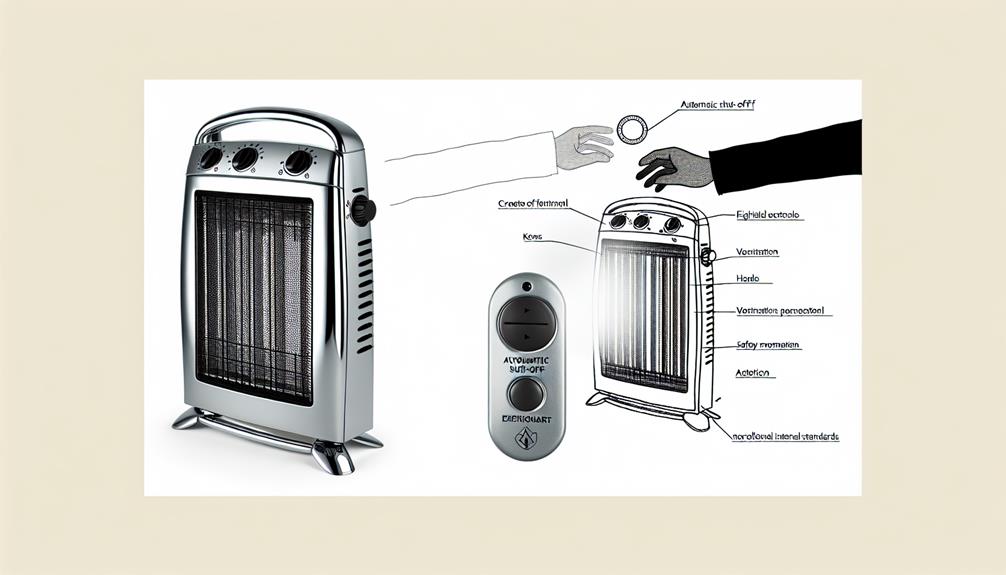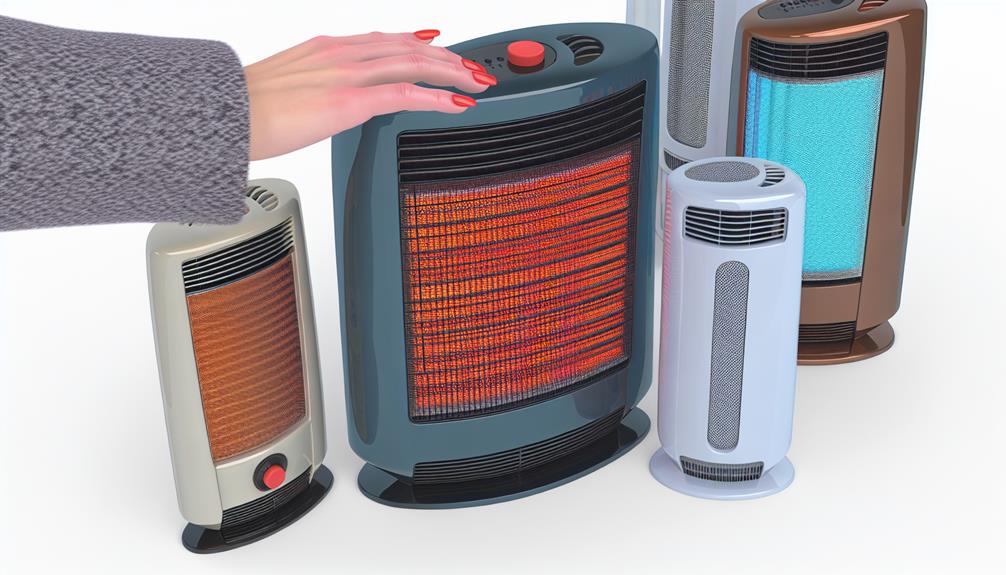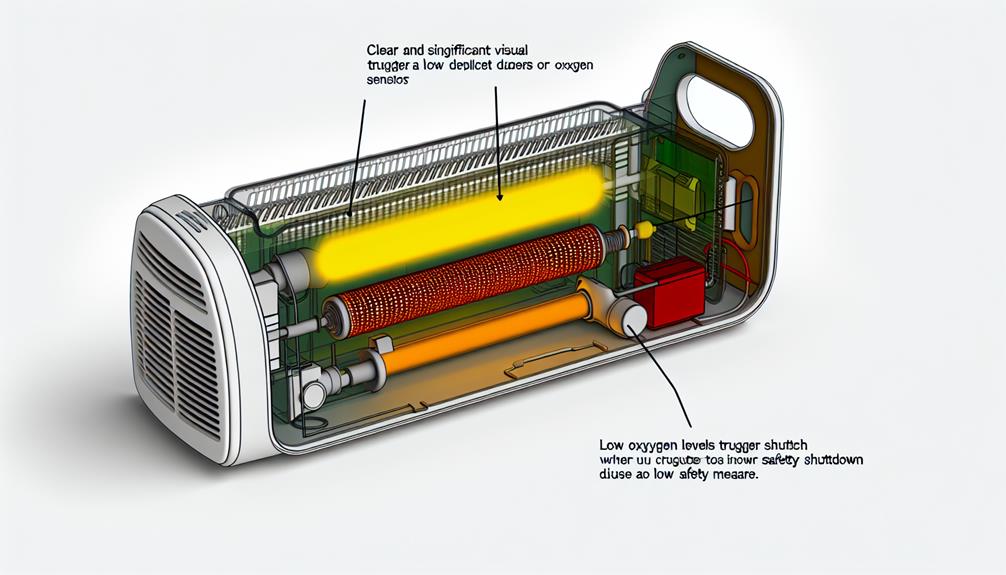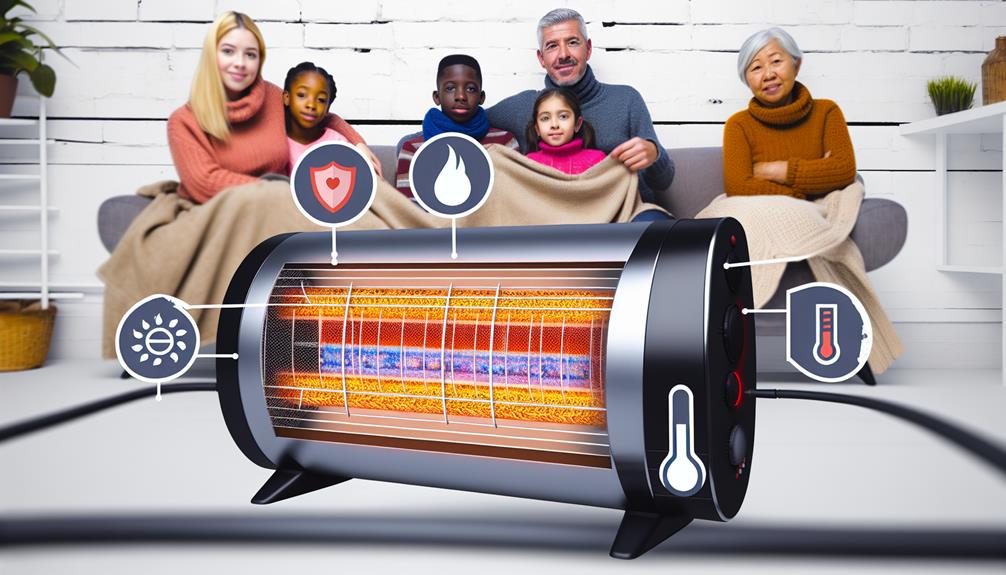Nearly 80% of home heating fire deaths are caused by portable heaters, according to the National Fire Protection Association, underscoring the critical importance of understanding the safety features in these common household devices. As you rely on these appliances to keep you warm during the colder months, it's essential to be aware of the advanced safety mechanisms that manufacturers have integrated to protect you and your loved ones. From automatic shut-off systems that kick in when a heater tips over, to overheat protection circuits that prevent potential fires, these features serve as silent guardians. However, the efficacy of such safety measures is only as good as your knowledge of them and how they function in unexpected situations. It's crucial for you to familiarize yourself with the intricacies of these systems—not just for peace of mind, but for the practical safety of your home environment. By exploring these features further, you'll uncover how modern technology not only brings comfort but also ensures that warmth doesn't come at the cost of safety.
Key Takeaways
- Automatic shut-off mechanisms, overheat protection features, thermal cut-out function, and oxygen depletion sensors are important automatic safety features in modern portable heaters.
- Temperature control sensors, precise temperature control sensors, sensor calibration and thermostat accuracy, and advanced sensors for real-time data are crucial for temperature monitoring and control in portable heaters.
- Tip-over safety switches, weight-activated or position-sensitive systems, and disrupted electrical circuits are essential for tip-over safety in portable heaters.
- Cool exteriors, materials engineered for high thermal resistance, minimization of heat transfer, and dual-wall construction or air gap for insulation are key features for cool-to-touch exteriors in portable heaters.
Automatic Shut-Off Mechanisms

One critical safety feature in modern portable heaters is the automatic shut-off mechanism, which instantly cuts power if the unit overheats or tips over, significantly reducing the risk of fire hazards. This mechanism is a pivotal component in the heater's integrated safety system, designed to mitigate potential accidents associated with the device's operation.
Analytically speaking, the shut-off mechanism operates through a series of sensors that continually monitor the heater's internal temperature and orientation. When a sensor detects that the heater exceeds a pre-set temperature threshold, indicative of overheating, it triggers the circuit interrupters. These interrupters, in turn, disrupt the electrical flow, thereby deactivating the heating element and preventing further temperature escalation.
Moreover, in the context of a heater tipping over, a position-sensitive switch, often a ball-bearing or mercury switch, detects the change in orientation. Upon this detection, the switch activates the circuit interrupter, which ceases power to the unit. This prompt response is crucial in preventing the heated elements from coming into contact with flammable materials, which could result in ignition.
Technical details of the shut-off mechanism also extend to its interaction with pilot lights in gas-fueled portable heaters. The system is engineered to extinguish the pilot light automatically if the flame goes out unexpectedly or if a tip-over occurs. This is essential to prevent the release of unburned gas, which poses a significant explosion risk.
Overheat Protection Features
You must consider the integral role of overheat protection features in maintaining the safety and longevity of your portable heater. These features, including the automatic shut-off mechanism and thermal cut-out function, are engineered to interrupt power when internal temperatures exceed safe operational levels. Precise temperature control sensors act as critical components in this safety matrix, constantly monitoring and adjusting to prevent overheating hazards.
Automatic Shut-off Mechanism
A crucial safety feature in modern portable heaters is the automatic shut-off mechanism, designed to prevent overheating by terminating operation when internal temperatures exceed safe limits. Sensor reliability is paramount in this system, as it directly influences the efficacy of the shut-off protocol. Moreover, maintenance reminders are typically integrated to ensure that the sensors and other critical components remain in optimal condition.
- Sensor Checks: Regular monitoring to confirm sensors are functioning correctly.
- Heat Thresholds: Precise calibration to detect unsafe temperature levels.
- Circuit Interruption: Immediate power cut-off to halt heating element operation.
- Component Durability: Use of materials that withstand high temperatures without degrading.
- User Alerts: Notifications or warnings when the heater is automatically turned off.
It's essential to understand these mechanisms to appreciate the technical sophistication that ensures your safety.
Thermal Cut-out Function
Building on the foundation of automatic shut-off mechanisms, the thermal cut-out function serves as a critical layer of overheat protection, promptly disabling the heater when a preset temperature is exceeded to mitigate fire risks. This system functions through precise thermal sensors which monitor the appliance's core temperature. Upon detecting an abnormal heat rise, indicative of potential overheating, the circuitry triggers the thermal cut-out. This is where circuit breakers play a pivotal role. They're designed to interrupt the electrical flow, effectively cutting power to the heater's elements before reaching a dangerous temperature threshold. Moreover, fuse integration complements this by providing a fail-safe; in case the thermal cut-out malfunctions, the fuse will blow when the current exceeds safety limits, adding an additional safeguard against overheating.
Temperature Control Sensors
Delving deeper into overheat protection, temperature control sensors are integral components that continuously gauge the heater's internal temperature, ensuring it operates within safe limits. These sensors are crucial for preventing potential overheating scenarios that could lead to fire hazards or damage to the heater itself. For optimal function, consider the following:
- Sensor calibration must be precise to ensure reliable temperature readings.
- Thermostat accuracy is vital for maintaining the desired level of warmth while avoiding overheating.
- Advanced sensors can adjust heating output based on real-time temperature data.
- Regular testing is important to maintain sensor effectiveness.
- Sensor failure could result in unsafe operation, necessitating immediate attention.
Understanding the technicalities of these sensors can help you recognize their importance in heater safety and functionality.
Tip-Over Safety Switches
To ensure user safety, modern portable heaters often incorporate tip-over safety switches, which automatically cut power if the device is knocked over. This mechanism is a critical component of a heater's stability design, serving as a proactive measure to prevent potential fire hazards or damage to the unit. When evaluating heaters, it's essential to consider models that have undergone rigorous safety certification processes, which include testing the effectiveness and reliability of their tip-over protection.
These switches are typically positioned at the base of the heater, utilizing a weight-activated system or a position-sensitive device that detects when the heater's orientation deviates from the upright position. Once triggered, the switch disrupts the electrical circuit, cutting power to the heating element and other operational components. This immediate response mitigates the risk of overheating surfaces coming into contact with flammable materials, a common cause of household fires.
In terms of technical specifications, you'll find that the sensitivity of these switches varies. Some are designed to activate with a minimal degree of tilt, while others may require a more significant angle to engage. The choice of sensitivity level can affect the user experience; overly sensitive switches may lead to frequent, unwarranted shutdowns, whereas less sensitive models could delay a necessary power cut-off.
Manufacturers calibrate tip-over safety switches during the design phase, aiming to strike a balance between user convenience and stringent safety standards. The calibration process involves testing the switch under multiple scenarios to ensure reliability across different surfaces and operating conditions. When you're in the market for a portable heater, scrutinize the product specifications and look for mentions of the switch's design and testing background. This information can provide assurance that the heater you choose not only keeps you warm but does so with your safety as a priority.
Cool-to-Touch Exteriors

You're likely aware that the inclusion of cool-to-touch exteriors on portable heaters is critical for preventing burns, but you may not have considered the technical nuances that make this feature effective. The materials used in these exteriors are engineered to have high thermal resistance, ensuring that heat transfer is minimized even while the internal components reach high temperatures. Additionally, for homes with children or pets, this safety characteristic is indispensable, as it reduces the risk of accidental injuries from contact with the heater's surface.
Importance of Cool Exteriors
While portable heaters provide a convenient source of warmth, it's crucial to consider safety features, such as cool-to-touch exteriors, which prevent accidental burns and enhance user safety. These exteriors are specifically engineered to ensure heat dispersion and exterior insulation are effective enough to maintain a safe surface temperature.
Here's why cool exteriors are vital:
- Prevention of Burns: They reduce the risk of accidental skin contact burns.
- Child and Pet Safety: Offer protection for curious children and pets.
- Material Safety: Minimize the risk of heat damage to surrounding materials.
- Improved Comfort: Allow you to move the heater without waiting for it to cool down.
- Enhanced Longevity: Protect internal components from overheating, extending the heater's lifespan.
How Cool Surfaces Work
Most portable heaters equipped with cool-to-touch exteriors utilize advanced materials and engineering to dissipate heat effectively, maintaining a lower surface temperature even when the unit is operating at high settings. This is achieved through the integration of surface technology and insulation materials that are designed to be poor conductors of heat. These materials act as a barrier, reducing the rate of heat transfer from the internal heating elements to the outer casing. The technical design often involves a dual-wall construction or air gap, which serves as an additional insulating layer, further impeding heat flow. Consequently, the exterior remains safe to touch, preventing burns upon contact. Your heater's ability to remain cool on the outside is a direct result of these meticulous engineering choices.
Child and Pet Safety
Ensuring the safety of children and pets, portable heaters with cool-to-touch exteriors are engineered to minimize the risk of accidental burns, making them a crucial feature in household safety. These heaters are designed with precision to provide heat without a hot surface, incorporating multiple layers of insulation and advanced materials that dissipate heat effectively.
Here's what you need to look for:
- Thermal Insulation: Layers that prevent the exterior from getting hot.
- Advanced Materials: Components that resist high temperatures.
- Automatic Shutoff: Turns off the heater if tipped over.
- Pet Proof Designs: Structures that deter pets from getting too close.
- Safety Certification: Look for marks from recognized testing laboratories.
These technical specifications ensure that the heater operates safely, even in environments with curious kids and pets. Safety certification serves as a testament to the rigorous testing and standards met by these devices.
Oxygen Depletion Sensors

Oxygen depletion sensors (ODS) are critical safety components in portable heaters, designed to detect reduced oxygen levels and automatically shut off the unit to prevent carbon monoxide buildup. As you monitor your heater's performance, it's essential to understand how these sensors play a pivotal role in maintaining a safe environment. The ODS functions by continually measuring the oxygen and gas concentration in the surrounding air. When the oxygen level dips below a pre-set threshold—typically around 18.5%—the sensor triggers a mechanism that cuts off the fuel supply, thereby extinguishing the flame and halting the production of potentially lethal carbon monoxide.
Your awareness of ventilation requirements is crucial when using gas-powered portable heaters. Without adequate ventilation, oxygen levels can decrease rapidly, and harmful gases may accumulate. The ODS is engineered to respond to such scenarios, but it should not be your sole reliance for safety. Ensuring proper airflow and adhering to the manufacturer's instructions for use and placement can significantly complement the ODS's function.
The technical specifications of an ODS involve a precision-crafted pilot assembly with a built-in thermocouple. This thermocouple detects the temperature decrease caused by a reduction in flame size as oxygen levels fall. It then generates an electrical signal that actuates the valve to shut off. It's a fail-safe designed to be sensitive and responsive to even minimal changes in gas concentration and oxygen levels.
Child Lock Functionality
In the realm of portable heater safety, the child lock feature stands as a critical component, designed to prevent accidental adjustments or activation by children, thereby mitigating potential hazards associated with unsupervised use. When you're assessing the safety features of a portable heater, it's crucial to understand how the child lock functionality integrates with the device's overall safety system. This technical safeguard aligns with rigorous safety standards, ensuring that the heater's operation remains exclusively in the hands of adults.
Parental controls like the child lock are not just an added perk; they are an essential aspect of a responsible safety protocol. Here's what you need to keep in mind:
- Activation Mechanism: The child lock is typically engaged through a combination of buttons that, when pressed simultaneously, activate the lock.
- Indicator: A visual or auditory signal confirms the activation or deactivation, which is critical to notify you of the current status.
- Override Function: In the event of an emergency or need for a quick deactivation, there's usually a straightforward method to override the child lock.
- Integration with Other Safety Features: The child lock often works in conjunction with other safety mechanisms, such as tip-over switches and overheat protection.
- Compliance with Standards: Ensure the heater adheres to current safety standards, which dictate the efficacy of the child lock feature.
As you delve into the technicalities of the child lock feature, remember that it's a preventative tool geared towards eliminating the risk of injury or accidents. Manufacturers are tasked with designing this function to be intuitive yet secure, preventing tampering by curious little hands while maintaining user-friendly operation for adults. Always look for heaters that proudly meet or exceed safety standards, with parental controls that give you peace of mind while keeping your family warm.
Flame-Resistant Materials

Beyond the electronic safeguards, the incorporation of flame-resistant materials is a fundamental aspect of portable heater design, directly influencing the unit's ability to withstand high temperatures without compromising structural integrity. You must understand that material durability and combustion resistance are not mere buzzwords; they're the linchpins of safety in any heating device you bring into your home.
Now, let's break down the components typically used:
| Material Type | Durability Features | Combustion Resistance |
|---|---|---|
| Thermoplastics | High melting points | Self-extinguishing properties |
| Ceramics | Wear resistance | Non-combustible |
| Metals | Structural strength | High-temperature tolerance |
Thermoplastics are selected for their melting points which far exceed the normal operating temperatures of portable heaters. They often possess self-extinguishing properties, which means they'll stop burning once the heat source is removed. Ceramics are valued for their exceptional wear resistance and are inherently non-combustible, which makes them ideal for components that come in direct contact with heating elements. Metals are not typically thought of as flame-resistant, but their high structural strength and ability to tolerate extreme temperatures without degradation make them indispensable in areas where structural integrity is paramount.
You're dealing with sophisticated engineering that ensures your portable heater's exterior remains cool to the touch, even when the internal components are operating at their peak. This is a direct consequence of selecting materials with high combustion resistance, which actively prevents fire hazards.
Programmable Timers and Thermostats
While the choice of materials ensures the physical robustness of portable heaters, programmable timers and thermostats provide an additional layer of safety by precisely regulating operation times and heat output. You'll find that the incorporation of these features not only enhances safety but also significantly improves energy efficiency, which is paramount in today's eco-conscious market.
Programmable timers allow you to set specific operating times for your heater, ensuring that it's only on when needed. This targeted use reduces the risk of overheating and potential fire hazards, as the heater won't operate unchecked for extended periods. Meanwhile, thermostats maintain the desired temperature by cycling the heater on and off, preventing the space from becoming excessively hot.
Smart integration takes this a step further by enabling you to control your heater remotely via a smartphone or voice assistant. This adds a level of convenience and safety, as you can adjust settings or turn the heater off even when you're not physically present.
Consider these technical aspects that enhance both safety and energy efficiency:
- *Programmable Timers*: Automate operation schedules to prevent unnecessary usage.
- *Adjustable Thermostats*: Maintain consistent temperatures and reduce energy waste.
- *Remote Access*: Manage heater settings from anywhere, at any time.
- *Usage Monitoring*: Track energy consumption to identify opportunities for savings.
- *Automatic Shut-off*: Engage safety protocols if abnormal temperature fluctuations are detected.
Frequently Asked Questions
How Does the Altitude of My Location Affect the Performance and Safety of My Portable Heater?
At higher altitudes, you'll experience reduced air pressure and lower oxygen levels, which can impact your portable heater's function. It's crucial to consider high altitude adaptation. The heater may work less efficiently and safety mechanisms, particularly those preventing oxygen depletion, must be more sensitive. Technically, as altitude increases, the risk of incomplete fuel combustion rises, potentially releasing harmful byproducts, thus demanding advanced safety features in your heater's design.
Can Using an Extension Cord With a Portable Heater Pose a Safety Risk, and if So, How Can I Mitigate It?
Yes, using an extension cord with a portable heater can increase fire risk due to potential overheating. To mitigate it, you should opt for cord alternatives like a direct wall plug or a heavy-duty extension rated for high wattage appliances. Ensure the cord's gauge is adequate for your heater's power requirements, and regularly inspect for damage. By doing so, you'll minimize the extension risks associated with portable heaters.
Are There Specific Safety Concerns When Using Portable Heaters in Spaces With High Humidity, Such as Bathrooms or Kitchens?
When using portable heaters in humid areas like bathrooms, moisture resistance is crucial. Imagine your heater exposed to steam from a shower, without proper shielding, it's a hazard. Look for models designed for such environments, which typically feature moisture-resistant construction. Additionally, plug your heater into GFCI outlets to prevent electric shock. These outlets cut power if they detect an imbalance, providing an essential safety layer in high-humidity conditions.
What Maintenance Steps Should I Regularly Take to Ensure My Portable Heater Remains Safe to Use Over Time?
To maintain your portable heater's safety, you should regularly perform filter cleaning to prevent dust accumulation, which can pose a fire risk. Cord inspection is also crucial; look for any signs of wear, fraying, or damage that could lead to electrical hazards. Ensure the heater is unplugged before conducting any maintenance. These steps are vital for optimal performance and to minimize the risk of accidents over time.
How Does the Presence of Pets in the Home Influence the Choice of Safety Features in a Portable Heater?
When choosing a portable heater, it's like picking a teammate in a tag game—you want one that won't trip you—or your pets—up. Pet-proof designs with advanced temperature control are crucial. You'll need a heater that's sturdy, with a tip-over switch, and has a cool-touch exterior. It's about analyzing the nitty-gritty: ensuring the heater's tech can outsmart a curious paw or an accidental nudge, keeping tails wagging safely.
